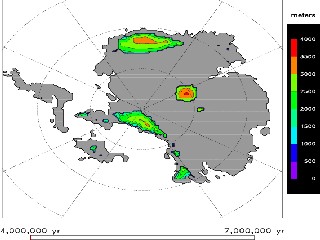- HOME |
- PEOPLE |
- RESEARCH |
- PUBLICATIONS |
- NEWS AND EVENTS |
- SEMINARS
Animations of Antarctica
Courtesy of Dr. David Pollard
Click on image to download animation
Animation: Typical collapse and regrowth event of the West Antarctic ice sheet. Relative model time does not represent a specific time in history. However, the generally stable period shown in the first 3000 years is roughly analogous to the past 3000 years of Earth history.
Reference: D. Pollard, and DeConto, R.D. 2009. Modelling West Antarctic ice sheet growth and collapse through the past five million years. Nature, 458,329-332.
Abstract: The West Antarctic ice sheet (WAIS), with ice volume equivalent to ~5 m of sea level, has long been considered capable of past and future catastrophic collaps. Today, the ice sheet is fringed by vulnerable floating ice shelves that buttress the fast flow of inland ice streams. Grounding lines are several hundred metres below sea level and the bed deepens upstream, raising the prospect of runaway retreat. Projections of future WAIS behaviour have been hampered by limited understanding of past variations and their underlying forcing mechanisms. Its variation since the Last Glacial Maximum is best known, with grounding lines advancing to the continental-shelf edges around ~15 kyr ago before retreating to near-modern locations by ~3 kyr ago. Prior collapses during the warmth of the early Pliocene epoch and some Pleistocene interglacials have been suggested indirectly from records of sea level and deep-sea-core isotopes, and by the discovery of open-ocean diatoms in subglacial sediments. Until now, however, little direct evidence of such behaviour has been available. Here we use a combined ice sheet/ice shelf model capable of high-resolution nesting with a new treatment of grounding-line dynamics and ice-shelf buttressing to simulate Antarctic ice sheet variations over the past five million years. Modelled WAIS variations range from full glacial extents with grounding lines near the continental shelf break, intermediate states similar to modern, and brief but dramatic retreats, leaving only small, isolated ice caps on West Antarctic islands. Transitions between glacial, intermediate and collapsed states are relatively rapid, taking one to several thousand years. Our simulation is in good agreement with a new sediment record (ANDRILL AND-1B) recovered from the western Ross Sea, indicating a long-term trend from more frequently collapsed to more glaciated states, dominant 40-kyr cyclicity in the Pliocene, and major retreats at marine isotope stage 31 (~1.07 Myr ago) and other super-interglacials.
Animation: Antarctic ice sheet thicknesses during a 10 million year simulation across the Eocene-Oligocene Boundary ~34 Ma, in response to gradually declining atmospheric CO2 and higher frequency orbital forcing.
Reference: DeConto, R.D. and D. Pollard, 2003. Rapid Cenozoic glaciation of Antarctica triggered by declining atmospheric CO2. Nature, 421, 245-249.
Abstract: The sudden, wide-spread glaciation of Antarctica and the associated shift toward colder temperatures at the Eocene/Oligocene boundary (~34 Ma)1-4 is one of the most fundamental reorganizations of the global climate system recognized in the geologic record. The established paradigm for the glaciation of Antarctica centers on the tectonic opening of Southern Ocean gateways, allowing the formation of the Antarctic Circumpolar Current (ACC), subsequent thermal isolation of the Antarctic continent, and glacial inception5. This inception and early growth of the East Antarctic Ice Sheet (EAIS) is simulated using a coupled GCM-dynamical ice sheet-sediment model, accounting for paleogeography, greenhouse gas concentrations, changing orbital parameters, and varying ocean heat transport. In our model, declining Cenozoic CO2 first allows small, highly dynamic ice caps to form on high Antarctic plateaus. Later, a CO2 threshold is crossed, initiating ice-sheet height-mass balance feedbacks that allow the ice caps to expand rapidly with large orbital variations, eventually coalescing into a continental-scale EAIS. The opening of Southern Ocean gateways is shown to play a secondary role to CO2 in the Paleogene “greenhouse” to “icehouse” transition.
 Animation: Flowline simulation of a combined ice sheet-shelf-sediment model over 10 million years, showing inland glacial erosion and deposition of continental-shelf sediments.
Animation: Flowline simulation of a combined ice sheet-shelf-sediment model over 10 million years, showing inland glacial erosion and deposition of continental-shelf sediments.
Animation: Flowline simulation of a combined ice sheet-shelf-sediment model over 10 million years, showing isochrons that represent strata in the modeled sediment deposits.
Reference: Pollard, D. and R. M. DeConto, 2006. A Coupled Ice-Sheet / Ice-Shelf / Sediment Model applied to Antarctica. Submitted to International Association of Sedimentologists Special Publication, for IAS Conference on Glacial Sedimentary Processes and Products, 22-27 August 2005, University of Wales, Aberystwyth.
Abstract: A standard large-scale ice-sheet model is extended by (i) adding ice stream-shelf flow using a combined set of scaled equations for sheet and shelf flow, and (ii) coupling with a deforming sediment model that predicts bulk sediment thickness. The combination of sheet and shelf flow equations is heuristic, but allows both horizontal shear and longitudinal stretching without a priori assumptions about the flow regime, and the grounding line is free to migrate. The sediment model includes bulk transport under ice assuming a weakly non-linear till rheology, and generation of till by glacial erosion. The combined model explicitly simulates off-shore sediment strata, enabling direct comparisons with the extensively studied Cenozoic glacimarine sediment record on Antarctic continental shelves. Preliminary 1-D flowline simulations are described on a linearly sloping domain, with simple prescribed spatial and temporal variations of surface ice mass balance. Each simulation is run for 10 million years, and the various patterns of offshore sediment strata built up over the course of each run are examined. A wide variety of sediment patterns is produced depending on uncertain model parameters, including unforced irregular oscillations in the absence of external forcing variations. The results are not conclusive, but illustrate the variety of possible interactions that may play a role as more definitive 3-D models become available to directly link Cenozoic climate variations with the Antarctic glacimarine sediment record.



